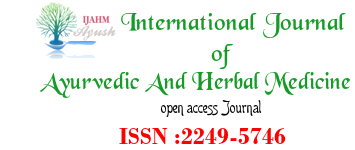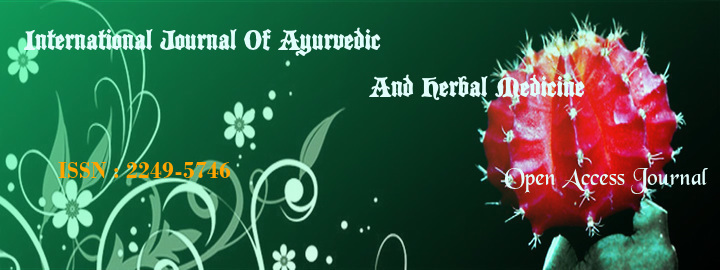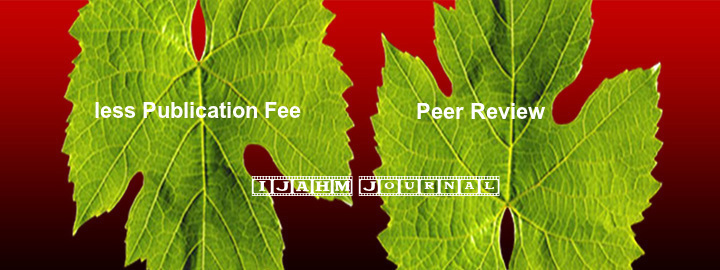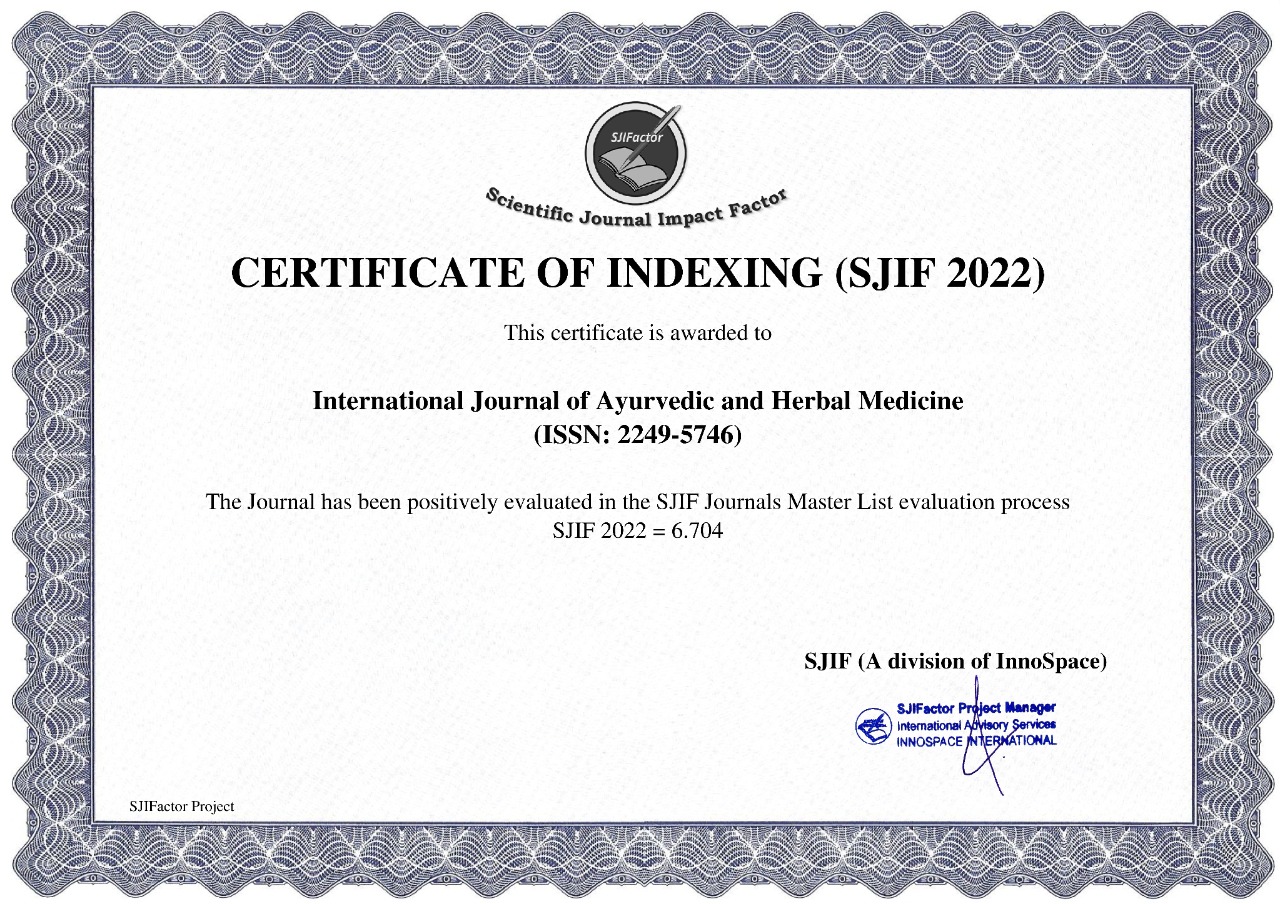


Qamar Uddin*, Amanullah, Khalid M. Siddiqui, Rais-ur-Rahman
Central Council for Research in Unani Medicine (CCRUM), Janakpuri, New Delhi-110058, India
*Corresponding Author, E-mail: This email address is being protected from spambots. You need JavaScript enabled to view it.
Abstract
Cancer is a significant global healthcare problem, with an estimated worldwide incidence of 10 million new cases per year, 46% of which are in developed countries. Mortality is high, with >7 million deaths per year. The goal of cancer treatment is first to eradicate the cancer. If this primary goal cannot be accomplished, the therapeutic goal shifts to palliation, the amelioration of symptoms, and preservation of the patient’s quality of life (QOL). In the last two decades, great advances have been made in cancer therapy; however, the success rates still remain unsatisfactory. Current conventional anticancer therapies are associated with adverse effects, drug resistance, and cancer recurrence. Therefore, there is still an urgent need for new therapeutic options for cancer. Current evidence, based on preclinical studies suggests that some Unani medicinal plants have anticancer potential. This review offers an evidence-based perspective of 20 Unani herbal drugs for the prevention and treatment of cancer. Several mechanisms are likely to account for the observed pharmacological effects, the most important being direct cytotoxicity, apoptosis induction, anti-oxidation, and immunomodulation. These Unani herbal drugs when combined with conventional anticancer therapy may help to synergize the anticancer effects, and reduce the side effects of conventional drugs, to improve the patient’s QOL, and to prevent cancer recurrence. However, well-designed and well-executed randomized controlled clinical trials (RCTs) are required to validate their usefulness and to make their use acceptable clinically in different types of cancers. Thus, these Unani medicinal plants may have turned into anticancer drugs.
REFERANCES
1. 1. Colledge NR, Walker BR, Ralston SH. Davidson’s Principles and Practice of Medicine. Edn 21, Churchill Livingstone, Elsevier Ltd, Philadelphia, 2010, 255-277.
2. Munjal YP, Sharma SK, Agarwal AK, Gupta P, Kamath SA, Nadkar MY, et al. API Textbook of Medicine. Edn 9, Vol. 2, The Association of Physicians of India, JP Brothers Medical Publishers (P) Ltd, 2012, 1556-1575.
3. Longo DL, Fauci AS, Kasper DL, Hauser SL, Jameson JL, Loscalzo J. Harrison’s Principles of Internal Medicine. Edn 18, Vol. 1, McGraw-Hill Companies, USA, 2012, 646-711.
4. Kumar V, Abbas AK, Fausto N, Aster JC. Robbins and Cotran Pathologic Basis of Disease. Edn 8, Saunders, Elsevier, Philadelphia, 2010, 292-366.
5. Williams NS, Bulstrode CJK, O’Connell PR. Bailey & Love’s Short Practice of Surgery. Edn 26, CRS Press, Taylor & Francis Group, Boca Raton, US, 2013, 125-146.
6. Goldman L, Schafer AI, Arend WP, Armitage JO, Clemmons DR, Drazen JM, et al. Goldman’s Cecil Medicine. Edn 24, Saunders, Elsevier, Philadelphia, 2012, 1164-1177.
7. Saad, B, Azaizeh H, Said O. Arab Herbal Medicine. Botanical Medicine in Clinical Practice. 2008; 4: 31.
8. Warrell DA, Cox TM, Firth JD, Benz Jr EJ. Oxford Textbook of Medicine. Edn 4, Vol. 1, Oxford University Press, New York, 2003, 193-260.
9. Shafi G, Hasan TN, Syed NA, Al-Hazzani AA, Alshatwi AA, et al. Artemisia absinthium (AA): a novel potential complementary and alternative medicine for breast cancer. Mol Biol Rep. 2012; 39(7):7373-9.
10. Suresh V, Sruthi V, Padmaja B, Asha VV. In vitro anti-inflammatory and anti-cancer activities of Cuscuta reflexa Roxb. J Ethnopharmacol. 2011; 134(3): 872-7.
11. Chatterjee D, Sahu RK, Jha AK, Dwivedi J. Evaluation of antitumor activity of Cuscuta reflexa Roxb. (Cuscutaceae) against Ehrlich Ascites Carcinoma in Swiss albino mice. Trop J Pharmaceu Res. 2011; 10(4): 447-454.
12. Udavant PB, Satyanarayana SV, Upasani CD. Preliminary screening of Cuscuta reflexa stems for anti-inflammatory and cytotoxic activity. Asi Paci J Trop Biomed. 2012; S1303-S1307.
13. Yahayo W, Supabphol A, Supabphol R. Suppression of Human Fibrosarcoma Cell Metastasis by Phyllanthus emblica Extract in Vitro. Asian Pac J Cancer Prev. 2013; 14(11): 6863-6867.
14. Haque R, Bin‑Hafeez B, Ahmad I, Parvez S, Pandey S, Raisuddin S. Protective effects of Emblica officinalis Gaertn. in cyclophosphamide-treated mice. Hum Exp Toxicol. 2001; 20:643‑50.
15. Hari KB, Sabu MC, Lima PS, Kuttan R. Modulation of haematopoetic system and antioxidant enzymes by Emblica officinalis gaertn and its protective role against γ-radiation induced damages in mice. J Radiat Res. 2004; 45:549-5.
16. Jindal A, Soyal D, Sharma A, Goyal PK. Protective effect of an extract of Emblica officinalis against radiation-induced damage in mice. Integr Cancer Ther. 2009; 8:98-105.
17. Singh I, Sharma A, Nunia V, Goyal PK. Radioprotection of Swiss albino mice by Emblica officinalis. Phytother Res. 2005; 19:444‑46.
18. Singh I, Soyal D, Goyal PK. Emblica officinalis (Linn.) fruit extract provides protection against radiation‑induced hematological and biochemical alterations in mice. J Environ Pathol Toxicol Oncol. 2006; 25:643‑54.
19. Sultana S, Ahmed S, Jahangir T. Emblica officinalis and hepatocarcinogenesis: A chemopreventive study in Wistar rats. J Ethnopharmacol. 2008; 118:1-6.
20. Jayaprakasam B, Zhang Y, Seeram NP, Nair MG. Growth inhibition of human tumor cell lines by withanolides from Withania Somnifera leaves. Life Sci. 2003; 74:125-32.
21. Yadav B, A. Bajaj A, Saxena M, Saxena AK. In Vitro Anticancer Activity of the Root, Stem and Leaves of Withania somnifera against Various Human Cancer Cell Lines. Indian J Pharm Sci. 2010; 72(5): 659-663.
22. Nema R, Khare S, Jain P, Pradhan A. Anticancer Activity of Withania somnifera (Leaves) Flavonoids Compound. Int J Pharm Sci Rev Res. 2013; 19(1): 103-106.
23. Rathi SG, Suthar M, Patel P, Bhaskar VH, Rajgor NB. In-vitro Cytotoxic Screening of Glycyrrhiza glabra L. (Fabaceae): A Natural Anticancer Drug. J Young Pharm. 2009; 1(3): 239-243.
24. Rahman S, Sultana S. Glycyrrhizin exhibits potential chemopreventive activity on 12-O-tetradecanoyl phorbol-13-acetate-induced cutaneous oxidative stress and tumor promotion in Swiss albino mice. J Enzyme Inhib Med Chem. 2007; 22: 363-369.
25. Nair PKR, Melnick SJ, Wnuk SF, Rapp M, Escalon E, Ramachandran C. Isolation and characterization of an anticancer catechol compound from Semecarpus anacardium. J Ethnopharm. 2009; 122(3): 450-456.
26. Sugapriya D, Shanthi P, Sachdanandam P. Restoration of energy metabolism in leukemic mice treated by Semecarpus anacardium Linn. nut milk extract. Chem Biol Interact. 2008; 173:43-58.
27. Mathivadhani P, Shanthi P, Sachdanandam P. Apoptotic effect of Semecarpus anacardium nut extract on T47D breast cancer cell line. Cell Biol Int. 2007; 31:1198-1206.
28. Dinesh MG, Rajasekaran S, Suneel R, Chandrasekaram K, Kalaivani R. Terminalia bellerica leaf extracts induce apoptosis in HepG2 cells and regulates cell cycle progression by inducing G2/M cell cycle arrest. Indian J Res Pharmacy Biot. 2014; 2(1): 1044-1057.
29. Kumudhavalli MV, Vyas M, Jayakar B. Phytochemical and pharmacological evaluation of the plant fruit of Terminalia belerica Roxb. Int J Pharmac Life Sci. 2010; 1(1):1-11.
30. Subbarayan PR, Sarkar M, Impellizzeri S, Raymo F, Lokeshwar BL, Kumar P, Agarwal RP, Ardalan B. Anti-proliferative and anti-cancer properties of Achyranthes aspera: specific inhibitory activity against pancreatic cancer cells. J Ethnopharmacol. 2010; 131(1): 78-82.
31. Geetha P, Narayanan KR, Murugesan AG. Screening the Anti-Cancerous Efficacy of Achyranthes aspera Linn. using Animal Model Swiss Albino Mice. J Biomed Sci and Res. 2010; 2(4): 231-235.
32. Singh SK, Shanmugavel M, Kampasi H, Singh R, Mondhe DM, Rao JM, Adwankar MK, Saxena AK, Qazi GN. Chemically standardized isolates from Cedrus deodara stem wood having anticancer activity. Planta Med. 2007; 73(6): 519-26.
33. Gaidhani SN, Singh A, Kumari S, Lavekar GS, Juvekar AS, et al. Evaluation of some plant extracts for standardization and anticancer activity. Indian J Traditional Knowledge. 2013; 12(4): 682-687.
34. Bhushan S, Singh J, Rao JM, Saxena AK, Qazi GN. A novel lignan composition from Cedrus deodara induces apoptosis and early nitric oxide generation in human leukemia Molt-4 and HL-60 cells. Nitric Oxide. 2006; 14(1):72-88.
35. Ali H, Dixit S. Extraction optimization of Tinospora cordifolia and assessment of the anticancer activity of its alkaloid palmatine. The Scient World J. 2013, 1-10.
36. Mishra A, Sharma AK, Kumar S, Saxena AK, Pandey AK. Bauhinia variegata leaf extracts exhibit considerable antibacterial, antioxidant, and anticancer activities. Bio Med Res Int. 2013, 1-10.
37. Verma R, Chaudhary HS, Agrawal RC. Evaluation of Anticarcinogenic and Antimutagenic Effect of Tinospora cordifolia in Experimental Animals. J Chem Pharm Res. 2011; 3(6):877-881.
38. Khan N, Sultana S. Anticarcinogenic effect of Nymphaea alba against oxidative damage, hyperproliferative response and renal carcinogenesis in Wistar rats. Mol and Cell Biochem. 2005; 271(1-2):1-11.
39. Arzu BY, Fatma PK, Arzu UT. In vitro antibacterial and antitumor activities of some medicinal plant extracts, growing in Turkey. Asi Pacif J Trop Med. 2012; 616-624.
40. Meenavangalapati, Prakash SDV, Satyanandam S. In-vitro anti-cancer studies of Chebulinic acid on colon adenocarcinoma ht-29 cell lines. Int J Pharm Pharm Sci. 2013; 5(2): 582-583.
41. Ahuja R, Agrawal N, Mukerjee A. Evaluation of anticancer potential of Terminalia chebula fruits against Ehrlich Ascites Carcinoma induced cancer in mice. J Scient Innovat Res. 2013; 2(3): 549-554.
42. Priscilla D, Jasmine R. Assessing the potential of the ethanolic extracts of Terminalia chebula against breast cancer. World J Pharmacy Pharmaceut Sci. 2013; 2(6): 5702-5708.
43. Son YO, Kim J, Lim JC, Chung Y, Chung GH, Lee JC. Ripe fruits of Solanum nigrum L. inhibit cell growth and induce apoptosis in MCF-7 cells. Food Chem Toxicol. 2003; 41: 1421-1428.
44. Jeong JB, Jeong HJ, Park JH, Lee SH, Lee JR, et al. Cancer-preventive peptide lunasin from Solanum nigrum L. inhibits acetylation of core histones H3 and H4 and phosphorylation of retinoblastoma protein (Rb). J Agric Food Chem. 2007; 55: 10707-13.
45. Oskoueian E, Abdullah N, Saad WZ, Omar AR, Ahmad S, Kuan WB, Zolkifli NA, Hendra R, Ho YW. Antioxidant, anti-inflammatory and anticancer activities of methanolic extracts from Jatropha curcas Linn. J Med Plant Res. 2011; 5(1):49-57.
46. Bagya SK, Rajashree PV, Sam KG. Preliminary anticancer screening and standardization of some indigenous medicinal plants using cell biology and molecular biotechnology based models. Res J Med Plant. 2011; 5(6): 728-737.
47. Balakrishnan SK, Bhat KI. Apoptosis and flowcytometric studies of Bauhinia variegata bark extract. Asi J Pharmaceut Cl Res. 2014; 7(1):
48. Mishra R, Kaur G. Aqueous ethanolic extract of Tinospora cordifolia as a potential candidate for differentiation based therapy of glioblastomas. PLOS ONE. 2013; 8(10): 1-13.
49. Sinha K, Verma AK. Evaluation of antimicrobial and anticancer activities of methanol extract of in vivo and in vitro grown Bauhinia variegata L. Int Res J Biol Sci. 2012; 1(6): 26-30.
50. Kumar MH, Ramesh C. Anticancer activity of Nano encapsulated formulation from the extracts of Picrorhiza kurroa against human cancer cell lines. J Pharmacog and Phytochem. 2014; 2(5): 182-185.
51. Rajkumar V, Guha G, Kumar RA. Antioxidant and anti-neoplastic activities of Picrorhiza kurroa extracts. Food Chem Toxicol. 2011; 49(2): 363-369.
52. Ruskin SR, Aruna SR. In-vitro and In-vivo antitumor activity of Catharanthus roseus. Int Res J Pharm App Sci. 2014; 4(6): 1-4.
53. Kainsa S, Kumar P, Rani P. Medicinal Plants of Asian Origin Having Anticancer Potential: Short Review. Asian J Biomed Pharmaceut Sci. 2012; 2(10): 01-07.
54. Ueda JY, Tezuka Y, Banskota AH, Antiproliferative activity of Vietnamese medicinal plants. Biol Pharmac Bull. 2002; 25(6): 753-60.
55. Wang S, Zheng Z, Weng Y. Angiogenesis and anti-angiogenesis activity of Chinese medicinal herbal extracts. Life Sci. 2004; 74(20): 2467-78.
56. Naveena, Bharath BK, Selvasubramanian. Antitumor activity of Aloe vera against Ehrlich Ascites Carcinoma (EAC) in Swiss albino mice. Int J Pharma and Bio Sci. 2011; 2(2): 400- 409.
57. Radovic J, Ivanic DM, Timotijevic G, Popadic S, Ramic Z, et al. Cell-type dependent response of melanoma cells to Aloe emodin. Food Chemic Toxicol. 2012; 50: 3181-3189.
58. Srividya AR, Aishwaria SN, Vishnuvarthan VJ. Evaluation of antioxidant, antimicrobial and cytotoxicity activity of hydroethanolic extract and its fractions of Acorus calamus Linn. Int J Pharmaceut Res Schol (IJPRS). 2014; 3(1): 114-125.
59. Sreejaya SB, Santhy KS. Cytotoxic properties of Acorus calamus in MCF-7 breast cancer cells. Int J Curr Res Aca Rev. 2013; 1(1): 106-111.
60. Khan MAA, Islam MT. Analgesic and cytotoxic activity of Acorus calamus L., Kigelia pinnata L., Mangifera indica L. and Tabernaemontana divaricata L. J Pharm Bioallied Sci. 2012; 4(2): 149-154.
61. Pai KS, Srilatha P, Suryakant K, Setty MM, Nayak PG, Rao CM, Baliga MS. Anticancer activity of Berberis aristata in Ehrlich ascites carcinoma-bearing mice: a preliminary study. Pharm Biol. 2012; 50(3): 270-277.
62. Das S, Das MK, Mazumder PM, Das S, Basu SP. Cytotoxic activity of methanolic extract of Berberis aristata DC on colon cancer. Global J Pharmacol. 2009; 3 (3): 137-140.
index























